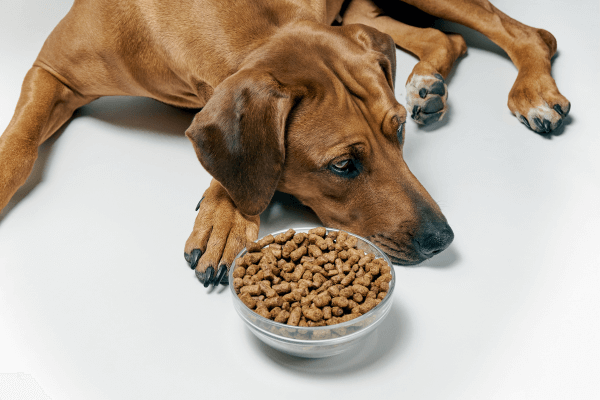Curious about the best dog food of 2025?
Read our review of Butternut Box.

Read our review of Butternut and discover why this dog food is so good!

Dry food – or kibble – is the go-to for many dog owners. It’s easy, tidy, and lasts forever in the cupboard. What’s not to love, right?
Well, here’s the thing: while kibble might work well for your schedule, it’s not necessarily doing your dog any favours. And once you scratch the surface, the downsides are hard to ignore.
Let’s put it this way – dry food is kind of like the fast food of the canine world. It fills the belly, but is it really nourishing your dog?
Most dry food is made through a process called “extrusion,” where the ingredients are blasted with heat and pressure at over 200°C. That’s how you get those neat, uniform little pellets that can sit on a shelf for months.
But the cost? A major loss of nutrients.
Vital vitamins like B, C and E are all destroyed during production. Manufacturers then add synthetic versions to make up for it – but that’s a bit like sprinkling vitamin powder on a bag of crisps and calling it a salad.
And it’s not just vitamins. Essential amino acids like lysine also break down, meaning the protein quality takes a serious hit. That’s not great news for your dog’s muscles, energy or overall wellbeing.
Kibble is hard, dry, and often packed with cheap carbs. Most dogs don’t even chew it properly – they gulp it down in seconds. The digestive system has to work overtime, especially if your dog isn’t drinking enough water.
What does that mean in real life? Think vomiting, bloating, flatulence, or worse – bloat (a twisted stomach), which can be life-threatening if not treated immediately.
And the gut bacteria? Those delicate ecosystems can be thrown off balance by dry food, making it harder for your dog to absorb nutrients and keep their digestion ticking along smoothly.
In the wild, dogs eat prey that’s naturally made up of around 70–80% moisture. Kibble? Often less than 10%.
Even if your dog has constant access to water, dry food often leaves them in a state of mild, chronic dehydration – and over time, that adds up. The kidneys have to work harder to flush out waste, which can lead to long-term damage and even kidney failure in older dogs.
You’ve probably heard this one before: “Dry food helps clean your dog’s teeth.” Unfortunately, it’s not quite true.
Most dogs don’t chew kibble enough for it to have any kind of scrubbing effect. Instead, food particles stick between their teeth, feeding the bacteria that cause plaque and tartar. Over time, this leads to gum disease and bad breath – not the dental health win we were hoping for.
A lot of dry food includes vague ingredients like “meat meal” or “animal derivatives” – terms that don’t tell you much about what’s actually inside. That’s a problem, especially for dogs with sensitivities.
Grains, gluten, and low-quality fillers can also irritate the gut lining, allowing larger food molecules to pass into the bloodstream. The immune system flags these as intruders, leading to food intolerances, itchy skin, digestive issues – and over time, full-blown allergies.
Dry food is ultra-processed – and there’s growing evidence (in both humans and animals) linking highly processed diets to cancer and metabolic diseases.
Studies show that even a 10% increase in processed food intake could raise cancer risk by 12%. Add to that the growing number of dogs with obesity, diabetes, high blood pressure and liver problems, and it’s hard to ignore the connection.
Let’s be realistic. Not everyone has the time or money to feed their dog freshly cooked meals every day. But you don’t have to go all-or-nothing to make a big difference.
Here’s what you can do:
Choose baked or cold-pressed food instead of extruded kibble
Add moisture – pour some warm water or low-sodium broth over the kibble
Mix in fresh foods – a bit of meat, veggies or even a raw egg can go a long way
Top it off with freeze-dried raw food for a protein boost
Support gut health with probiotics or digestive enzymes
Kibble might be convenient, but it’s not ideal. It keeps your dog alive – sure. But it doesn’t necessarily help them thrive.
You don’t have to overhaul your dog’s entire diet overnight. Even small tweaks can have a huge impact on their energy, digestion, skin, coat, and long-term health.
At the end of the day, your dog relies on you to make the right choices. And if you’ve read this far, you’re already doing something right.
Read our review of Butternut and discover why this dog food is so good!
